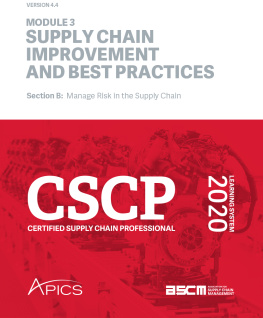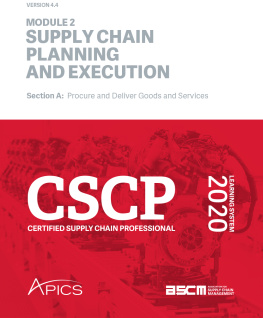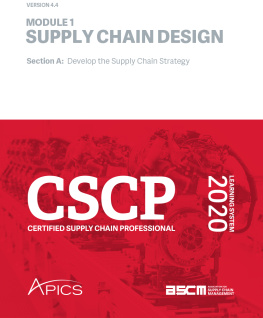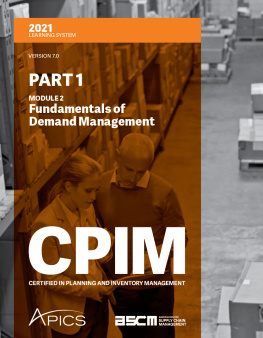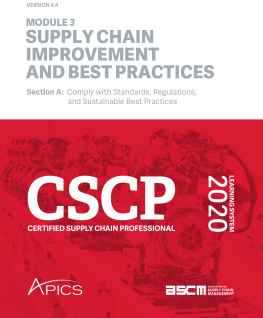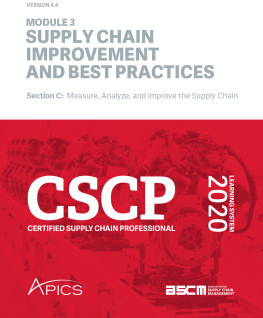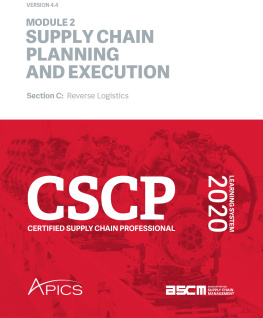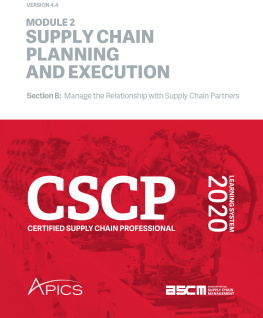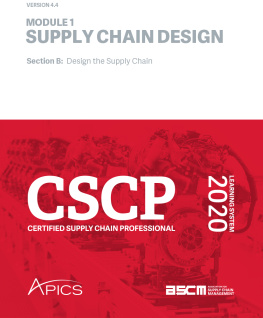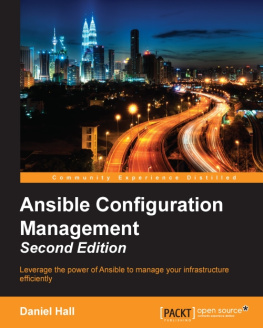APICS - CSCP 2020 Module 3 Section B
Here you can read online APICS - CSCP 2020 Module 3 Section B full text of the book (entire story) in english for free. Download pdf and epub, get meaning, cover and reviews about this ebook. genre: Business. Description of the work, (preface) as well as reviews are available. Best literature library LitArk.com created for fans of good reading and offers a wide selection of genres:
Romance novel
Science fiction
Adventure
Detective
Science
History
Home and family
Prose
Art
Politics
Computer
Non-fiction
Religion
Business
Children
Humor
Choose a favorite category and find really read worthwhile books. Enjoy immersion in the world of imagination, feel the emotions of the characters or learn something new for yourself, make an fascinating discovery.
- Book:CSCP 2020 Module 3 Section B
- Author:
- Genre:
- Rating:4 / 5
- Favourites:Add to favourites
- Your mark:
- 80
- 1
- 2
- 3
- 4
- 5
CSCP 2020 Module 3 Section B: summary, description and annotation
We offer to read an annotation, description, summary or preface (depends on what the author of the book "CSCP 2020 Module 3 Section B" wrote himself). If you haven't found the necessary information about the book — write in the comments, we will try to find it.
CSCP 2020 Module 3 Section B — read online for free the complete book (whole text) full work
Below is the text of the book, divided by pages. System saving the place of the last page read, allows you to conveniently read the book "CSCP 2020 Module 3 Section B" online for free, without having to search again every time where you left off. Put a bookmark, and you can go to the page where you finished reading at any time.
Font size:
Interval:
Bookmark:
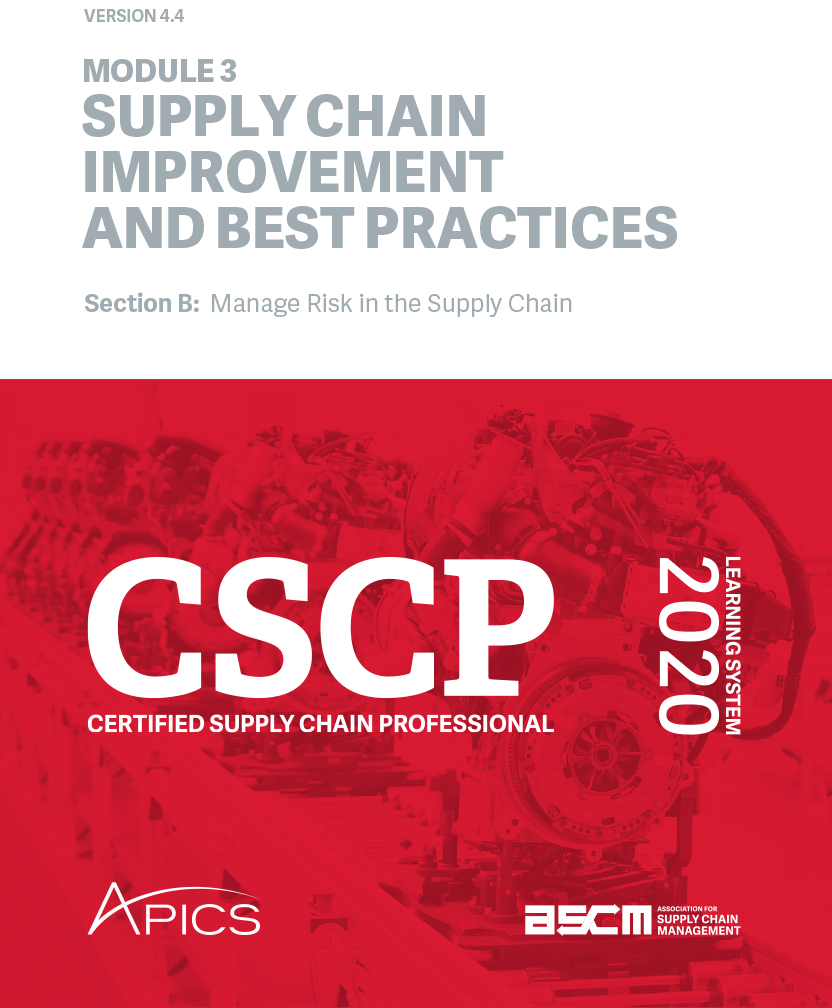
This section covers the basic process of risk identification, assessment, and classification to show how to devise a cost-effective response strategy for each risk, develop a risk response plan, and execute the plan as well as keep it up to date. It also elaborates on a number of common and emerging supply chain risks. The primary focus in this section is on risk associated with suppliers and procurement; risk associated with production, demand, and other logistics activities is discussed in greater detail in the APICS CLTD and CPIM Learning Systems.
Risk is generally defined as an uncertainty that could positively or negatively affect the accomplishment of business objectivesfor example, it could be an uncertainty related to delivery dates, quality, or revenue/cost. Negative risks also include hazards, sources of danger, lawsuits, or the possibility of incurring loss, misfortune, or injury.
The above definition of risk includes uncertainties that could have a positive impact. Risks are not always bad things, but they are always uncertain. Why does risk include things that could be positive? Because an uncertain investment might not produce the benefits that are desired, thus wasting the time and money put in up front. When a risk describes a positive uncertainty, it is called an opportunity. A threat is more precise term for just the negative types of risk. These are the opportunities and threats of a SWOT analysis, for example.
Risk is often defined only from a negative perspective, such as in the APICS Dictionary, 16th edition, definition of supply chain risk as
the variety of possible events and their outcomes that could have a negative effect on the flow of goods, services, funds, or information resulting in some level of quantitative or qualitative loss for the supply chain.
All investment involves uncertainty, including investing in a supply chain. Even a street food vendors operations can illustrate the threats and opportunities of managing a supply chain.
Imagine some of the possibilities. The vendor could have car trouble or an accident going to work. The vendors wife who serves as an at-home cook could fall ill and fail to prepare some of the items to be sold that day. Customers could get sick from eating spoiled product and sue. Regulators could shut the stand down for noncompliance with health regulations. The wholesale supplier or a nearby business that provides a great deal of foot traffic (customers) could go out of business. Bad weather could keep customers away, drive up the price of raw materials (food products or fuel), or destroy the stand. Police could cite the stand for lack of a license. Thieves could steal inventory while the vendor is busy. A regular customer might move out of the neighborhood. Street gangs might try to knock the stand down, cover it with graffiti, or intimidate the vendor or customers. A competitor could set up a cart nearby.
From an opportunities perspective, perhaps the vendor wants to expand to a new neighborhood. It may be that a vendor who worked that area has gone out of business and is offering his cart for sale at a bargain. Of course opportunities are still uncertain, so it may be that after purchasing the cart and more inventory and hiring a worker, due to different cultural backgrounds, no one buys the products.
The problems in this microcosm imply all the dangers that lie in wait for larger enterprises. And so do the solutions. In brief, a little redundancy might be in order as a buffer against most of these difficulties: availability of a second car, a neighbor who can help out in the kitchen, or a second or third source for supplies besides that wholesaler. The ability to sense and respond to issues can also help, such as moving the stand to where police are usually nearby to scare off thieves and vandals or establishing a personal relationship with customers to keep them from turning to that competitors stand. Finally, building an adaptable business and supply chain can make the organization resilient: A bit of research and contingency planning could help avoid disruptions caused by weather or inadvertent violations of the law. The vendor could reduce the uncertainty of the opportunity by finding out what people in a different neighborhood like to eat before purchasing and setting up a new stand. Redundancies, system visibility and responsiveness, and system adaptability can go quite a ways toward ensuring the steady operation of the food standor any organizationin the face of some potential disruptions or failed opportunities.
The potential issues with a street food vendor, though it is a very small business to be sure, mirror many of the risks that threaten real-world supply chains in the global marketplace. Consider the following examples of risks for global enterprises.
Example: A Canadian company that manufactures electric motors established new relationships with global vendors to accommodate booming international demand. A few seemingly justified shortcuts were taken in the initial site inspections to expedite the selection process. Subsequently, poor-quality issues have skyrocketed and external failure costs due to defective products being shipped to customers are eroding profits and damaging the companys reputation.
Example: A multinational medical device manufacturer experiences many service problems caused by technology incompatibilities with business partners and third parties. The root causea lack of open standards and problems with business process integration.
Example: Shipping seasonal textile goods made in Southeast Asia to a global retailer involves multiple parties, transportation modes, and port calls. Along the way, a political uprising paralyzes air freight and a labor dispute disrupts operations at a major port of call.
Example: A 2013 World Economic Forum report, Building Resilience in Supply Chains, indicated that cyber risk could have huge implications for supply chains. Indeed, a major U.S. retailer was the first of several retailers to have its customers personal data stolen by hackers. In that case, the credit and debit card account information of 70 million customers was stolen using malware introduced at the point of sale. The stores sales and reputation suffered and it spent money repairing the damage, offering zero liability for fraudulent charges and a years free credit monitoring and protection.
This chapter is designed to
Define risk, threat, and opportunity, and discuss some common supply chain risks
Discuss risk management and proactively addressing risks to reduce their impact or likelihood and preplanning a response if they occur anyway
Understand that some areas of supply chain risk are have more mature response systems than others at most organizations
Describe the importance of developing a strategy and plan for risk management, including specifying the organizations risk tolerance
List some common tools for identifying risk
Show how to document risks in a risk register
Elaborate on some common supply chain risks.
The key processes that supply chain managers need to be able to perform related to managing risk in the supply chain are
Identifying the risks
Assessing and classifying the risks
Developing a risk response plan
Font size:
Interval:
Bookmark:
Similar books «CSCP 2020 Module 3 Section B»
Look at similar books to CSCP 2020 Module 3 Section B. We have selected literature similar in name and meaning in the hope of providing readers with more options to find new, interesting, not yet read works.
Discussion, reviews of the book CSCP 2020 Module 3 Section B and just readers' own opinions. Leave your comments, write what you think about the work, its meaning or the main characters. Specify what exactly you liked and what you didn't like, and why you think so.

